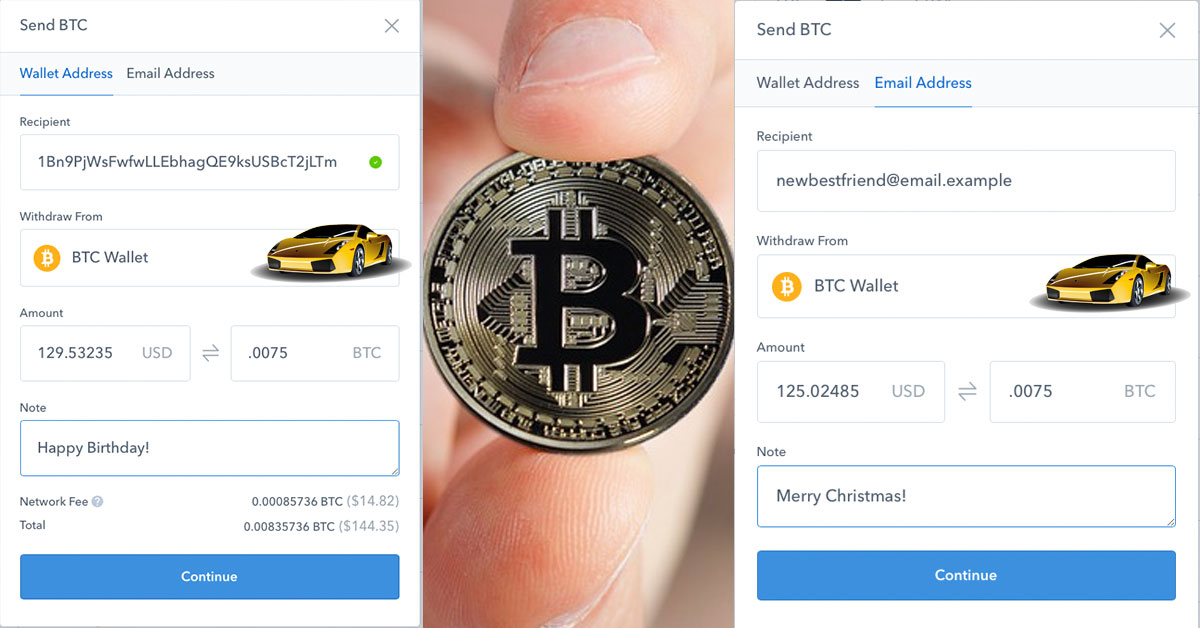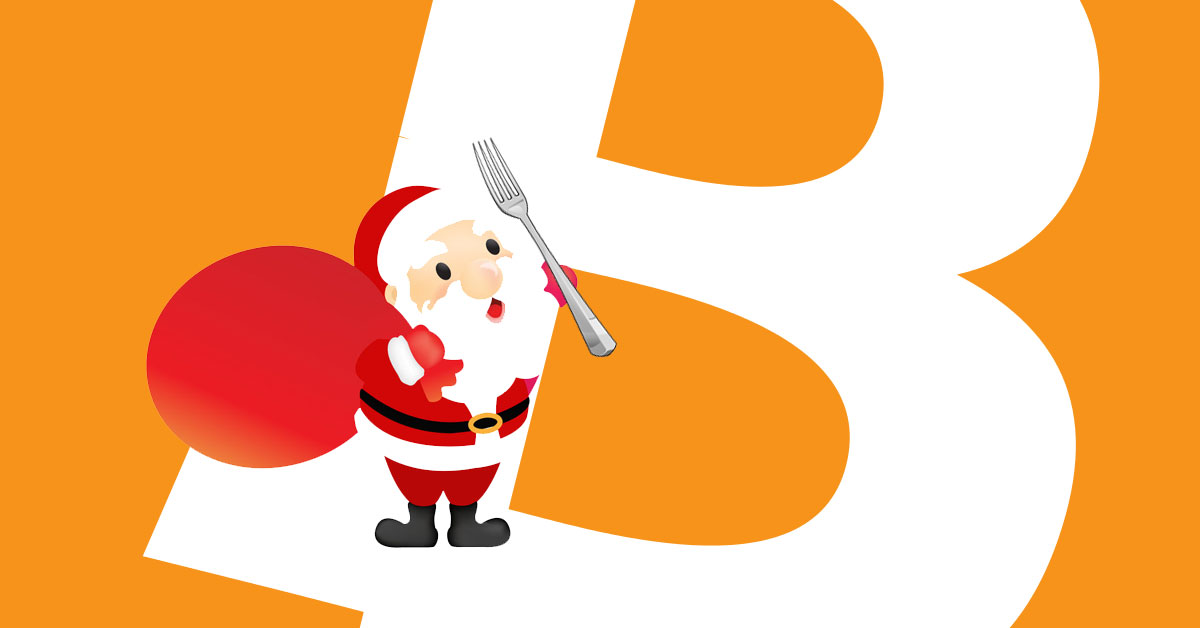How to Give Bitcoin (and Other Cryptocurrencies) as a Gift

How to Give the Gift of Bitcoin and Other Cryptocurrencies – A Guide for Beginners
We explain how to give Bitcoin and other cryptocurrencies as a gift (for example, how to give Bitcoin as a Christmas gift or Birthday gift).
The goal of this guide will be to walk someone who knows nothing about cryptocurrency through the process of buying some, giving it as a gift, and then selling it when they are ready.
Giving Bitcoin as a Gift Using Coinbase: Sign up for Coinbase, buy some Bitcoin, and then send your friend or loved one some Bitcoin using Coinbase. They’ll ideally want to sign up for Coinbase too. The same is true for Ethereum, Litecoin, Ethereum Classic, Bitcoin Cash, and more. If both of you have a Coinbase account, it is as simple as buying crypto and then sending it to them using the email attached to their Coinbase account. Later, they can sell by hitting the sell button under Bitcoin or the respective currency.

Cash App, a simple alternative for giving Bitcoin as a gift: You can use the Square Cash App to send Bitcoin to another Cash App user. You can’t buy other cryptos with the Cash App, so it does have some drawbacks versus Coinbase, but as a plus, it is arguably simpler and quicker than using Coinbase. To give Bitcoin as a gift using Cash App, simply download Cash App, buy Bitcoin, and then send the Bitcoin to another Cash App user using their $Cashtag!
The two methods above (Cash App and Coinbase) are simple and time-tested choices for giving Bitcoin as a gift. Even better is that they are both compatible, as both work as traditional custodial Bitcoin wallets. So if one person has Cash App and the other has Coinbase, Bitcoin can still be sent back and forth using receiving Bitcoin addresses. Remember though, if you want to give other cryptocurrencies as a gift, you’ll likely want to use Coinbase, as Cash App is limited to Bitcoin only. Below we offer more details on how to use Coinbase to give cryptocurrency as a gift.
Get $5 in Bitcoin When You Sign up For Coinbase: Get $5 free Bitcoin at Coinbase just for signing up coinbase-consumer.sjv.io/b3b0gk.
Get $5 free when you Sign up for Cash App and Send: The following link will get you $5 free that you can spend on Bitcoin after you send your first $5 https://cash.app/app/DFKVMQH.
What is Cryptocurrency?: Cryptocurrency is a name for digital currencies like Bitcoin. Ethereum, Bitcoin Cash, Ethereum Classic, and Litecoin are also cryptocurrencies. This guide will cover how to give any cryptocurrency on Coinbase as a gift using the Coinbase platform.
A Simple Summary of Giving Bitcoin as a Gift
NOTE: This guide walks you through using Coinbase to give cryptocurrency as a gift. Check out our guide to Cash App for Bitcoin for Cash App-specific steps, but do give the information below a read as well as a lot of the information is generally applicable.
To give Bitcoin or another cryptocurrency as a gift:
First: You need to be able to buy cryptocurrencies like Bitcoin. So step 1 is “sign up for Coinbase (click for our Coinbase explainer and guide).” Coinbase is one of the simplest and arguably best all-around choice for a place to buy Bitcoin in the U.S. Thus, it is what we’ll use as an example for this guide. TIP: If you want to use another exchange/broker to exchange dollars for cryptocurrency, that will work too. Of course, if you know how to do that, you can probably skip the first part of this guide anyway!
Second: You need to transfer some Bitcoin or another cryptocurrency to the person you are giving it to. You can send the cryptocurrency to an email address via Coinbase (explained below), get a paper wallet and load the cryptocurrency onto that (also explained below), or buy the cryptocurrency now but wait to transfer the cryptocurrency until you can help the other person set up a Coinbase account or other wallet solution first (also explained below). A paper wallet is cool because it will result in you being able to give a physical gift that the person can hold onto without being tech-savvy (the drawback is it is a little more complicated). Email is a solid choice, as it is fairly straightforward (either they will get a prompt to claim the Bitcoin via email, or they will automatically receive it if you send to an email associated with an existing Coinbase account). Meanwhile, waiting to help them with their Coinbase is the simplest solution, but requires you to find the time to sit down and do the process together. All these are fine choices, each with its pros and cons. We will cover each option below.
TRANSFERRING TO A BITCOIN ADDRESS: If you know a person’s public Bitcoin address, then sending Bitcoin is as simple as sending to that address from your Coinbase account and paying the fee. When you click “send” you can choose between sending to their address and sending directly to their account by typing in the email associated with the account. You can always write a note along with the transaction that only you and they can see. If you do this, keep in mind that people sometimes change addresses and Bitcoin sent to the wrong address cannot be recovered. See a guide on how to send Bitcoin that way.
NOTE: Unless y strongly suggest using the same platform. So in the case of Coinbase, both using Coinbase. In general, I think it’s best to send directly to another account using a person’s Bitcoin address or email than using a paper wallet. Using only Coinbase is simpler, more self-contained, and harder to mess up. Coinbase may not be what the pros use for long-term storage, but it’ll do the trick and be secure enough for a gift in almost all cases.
NOTE: Those who want the recipient to be able to store cryptocurrencies offline may consider giving a hardware wallet like the Nano S as a gift as well. You can buy cryptocurrency via Coinbase and then send that to the Nano S wallet to “preload” it for the recipient. I would strongly suggest avoiding that if you are unsure of what you are doing, as you’ll need to deal with backup codes and pins and such. Alternatively, you could simply give the Nano S (or another hardware wallet, for example, Trezor) alongside one of the other methods noted on this page for giving cryptocurrency as a gift. See directions for using a Nano S wallet for an example of how to load cryptocurrency onto a hardware wallet.
TIP: You can buy a fraction of a Bitcoin. The majority of Bitcoin traders deal in fractions of Bitcoins when they buy and sell. You don’t have to give someone a full Bitcoin as a gift. Think in terms of fiat. $100 worth of Bitcoin is a good choice, especially if you will use Coinbase to send it via email since that transaction fee will be free! The price you’ll pay depends on the current market price of Bitcoin plus fees.
A Step-By-Step Guide to Giving Bitcoin and Other Cryptocurrencies as a Gift
Below are step-by-step directions for giving Bitcoin, Litecoin, Ethereum Classic, Ethereum, or another cryptocurrency on Coinbase as a gift.
NOTE: If you want to give another cryptocurrency that isn’t on Coinbase, you’ll need to covert Bitcoin or Ether into that coin using an exchange like Bittrex or conversion platform like ShapeShift. That is more work for you and way more work for the person on the other end. Thus, we will save that explainer for another day. If you want to keep the transaction simple, start with Bitcoin in a Bitcoin wallet.
PART 1. SIGN UP FOR COINBASE
- Sign up for coinbase.com (click this link for $5 free Bitcoin when you sign up) to create an account for securely buying/selling/storing digital currency.
- Connect your bank account, debit card, or credit card so that you can exchange digital currency for your local currency (you’ll probably also want to add optional info and upload your ID to expand your purchasing limit). TIP: Yes, giving Coinbase all your personal info is intimidating, but everyone who uses Coinbase has to do this. Coinbase currently has 13 million users, more than Charles Schwab (if that makes you feel better).
- Buy Bitcoin, Ethereum, Ethereum Classic, Litecoin, or another coin on Coinbase (trading USD, aka US dollars, for cryptocurrency). To do this click on the buy/sell tab and hit buy. You’ll be able to sell just as easily later, assuming you link your bank account (you need to deposit the USD somewhere).
HOW TO PAY LESS IN FEES: You can avoid some fees by using Coinbase Pro instead of Coinbase. If you are tech-savvy there is no reason you can’t figure out Coinbase Pro. If not, the difference in fees doesn’t make a big difference. I
NOTE ON BANK ACCOUNT VS. CREDIT CARD: It can take time for your account to be verified. Then, if you are trying to use your bank account to make a purchase, it can take about a week to actually access the cryptocurrency after you hit the buy button. In other words, you have to do this a week before you want to give a gift if you use your bank account to buy cryptocurrency. To get around the wait times, use a credit card and pay the extra fee (not all accounts have wait times, many have “instant purchase” enabled. If this is the case, buying via your bank account is fine). There is a lot more to know, so if you want to get deeper and learn how to increase your buying limits and pay fewer fees, see our in-depth Coinbase guide.
PART 2. TRANSFER CRYPTOCURRENCY TO A COINBASE ACCOUNT, EMAIL, OR PAPER WALLET
If you want to limit the number of things that could go wrong, then don’t send to an email address unless you know for sure which email a person has associated with an existing Coinbase account. And, don’t use a paper wallet either. Just buy your crypto today and wait to transfer it until you are sitting down with the other person. Doing things this way avoids some [not all] transaction fees, headaches, and doubts about missing emails and making mistakes.
Thus, the first set of directions will be for transferring directly to another person’s account (see also how to send and receive cryptocurrency).
TIP: Once you know which email a person has associated with their Coinbase, then use their email address to send cryptocurrency to another Coinbase account. This method avoids the fees associated with sending directly to a Bitcoin address. To be clear, above we were cautioning against sending emails when you don’t know this information for sure, not against using this feature once you do!
NOTE: When a lot of trading is happing there can be high transaction fees. Consider sending cryptocurrency on a slow day if you are sending to a Bitcoin address and not directly to a Coinbase account via email. On a slow day, transaction fees will be lower, and transaction speeds will be faster. The one negative about transferring crypto on Christmas or any other major holiday is that it is likely to be a busy day for crypto due to people giving Bitcoin as a gift.
To transfer directly to another person’s Coinbase account:
- Make sure both you and the person getting the gift have a Coinbase account (or they could always simply download a Bitcoin, Litecoin, Ethereum Classic, Ethereum, etc wallet; Coinbase handles the wallet part for you, but you can use any wallet that is designed to hold a given coin).
- Assuming you are using Coinbase to send, click the “Accounts” button at the top of the screen on a desktop or at the bottom of the screen on mobile.
- Click the type of cryptocurrency you want to send.
- Then click the “send” button to “send” to an “address” (a Bitcoin, Litecoin, Ethereum Classic, Ethereum, etc address). TIP: On mobile, it’s a picture of a paper airplane in the top right corner).
- Enter the public address of the other person (or email if using email). If they are using Coinbase, they click “receive” under the coin in the accounts tab to produce the address (or the picture of a QR code next to the airplane in the top right corner). TIP: If you are on the same computer, open one person’s Coinbase in one browser, and the other person’s in another so you can copy and paste. If you are typing the number by hand and not scanning the QR code, then type very, very, very carefully (and triple-check the address). If you copy and paste the address, make sure to double-check it before you send.
- Triple check you didn’t mess up. Did you miss a zero or decimal?! Don’t miss a zero or decimal. Did you enter a private key instead of a public address? Did you enter an Ethereum address instead of a Bitcoin one? Don’t do any of that!
- Hit send.
- You have now sent the cryptocurrency to the person’s Coinbase wallet. You’ll pay some transaction fees, and you’ll have to wait for the order to clear, but you are done. You can check the status of the order in both peoples’ Coinbase accounts in the “accounts” section.
To send via email using Coinbase:
- Log into Coinbase.
- Click the “Accounts” button at the top of the screen on the desktop or a the bottom of the screen on mobile.
- Click the type of cryptocurrency you want to send.
- Then click send to email. You can toggle between sending to an “address” or an “email;” here we are choosing “email.”
- Enter the email address, the amount you want to send in Bitcoin or USD (or the Euro and British Pound), and write a message (the message will not be posted to the public; it is a private message between the sender and receiver).
- Triple check you didn’t mess up (did you miss a zero or decimal?! Don’t miss a zero or decimal).
- Hit send.
- You have now sent the cryptocurrency to the person’s email. They can then sign up for Coinbase and store it there or use that to buy/sell more (feel free to create your own referral link for them in your Coinbase or give them ours, everyone who creates a new account qualifies for the sign-up bonus).
To load cryptocurrency onto a paper wallet:
- Buy a paper wallet or make one for free on the internet (if you buy one it’ll take time to ship). You can use BitcoinPaperWallet.com for buying one, or you can make your own paper wallet by literally printing it onto paper.
- Regardless of which method you choose, you now have another step for yourself. The problem here is that you need to generate a public address and private key and you can’t do that via Coinbase (they are a third-party service that takes care of the complex stuff for you). Thus, the next step is to generate a wallet for Bitcoin using BitAddress or LiteAddress for Litecoin. I couldn’t find a quick wallet generator for Ethereum, but you can use MyEtherWallet to set one up (just be careful not to lose your private keys, or you’ll lose access to the wallet). And so on for other cryptocurrencies.
- Once you have the address, hit “print” and print out the public address and private key (and the QR codes that go along with them). Also, take a screenshot. You don’t want to lose this. TIP: If someone gets your private keys, or if you lose them, you lose everything. Never send Bitcoin to a private key, only send to the public address.
- Send the appropriate coin from Coinbase (or another wallet) to the address. To do this via Coinbase, go to the send/receive screen and choose to send to an address. If you copy and paste the address, make sure to double-check it before you send.
- Triple check you didn’t mess up. Always triple-check!
- Hit send.
- You now have a paper wallet with cryptocurrency loaded onto it which you can give as a gift. When the person is ready, they can send this back to Coinbase to cash out.
How to sell cryptocurrency: To sell cryptocurrency once you are ready, simply sell to USD in Coinbase. You can store that USD in your Coinbase USD wallet, or you can send the USD back to your bank account.
TIP: If you don’t want to give someone a paper wallet, you can give them a hardware wallet like TREZOR instead. If I were going to give someone a large amount of crypto to hold long-term, I’d keep the crypto in my wallet until I was ready, have them set up Trezor, and then transfer the crypto to that once they were set up and ready to go.
TIP: There are significant security concerns about creating a paper wallet. Although you can’t do this with MyEtherWallet without downloading some software (see How To Run MyEtherWallet Offline and Locally), you can load BitAddress or LiteAddress in your web browser and then go offline before you generate an address. This will help ensure you aren’t running into issues with malware. You can also disconnect your printer from the internet before printing everything out. The problem is that your private key is a direct portal into your wallet. If anyone gets your private and public key, they can access your funds, and nothing can be done about it. See more at How to Make a Paper Bitcoin Wallet.
